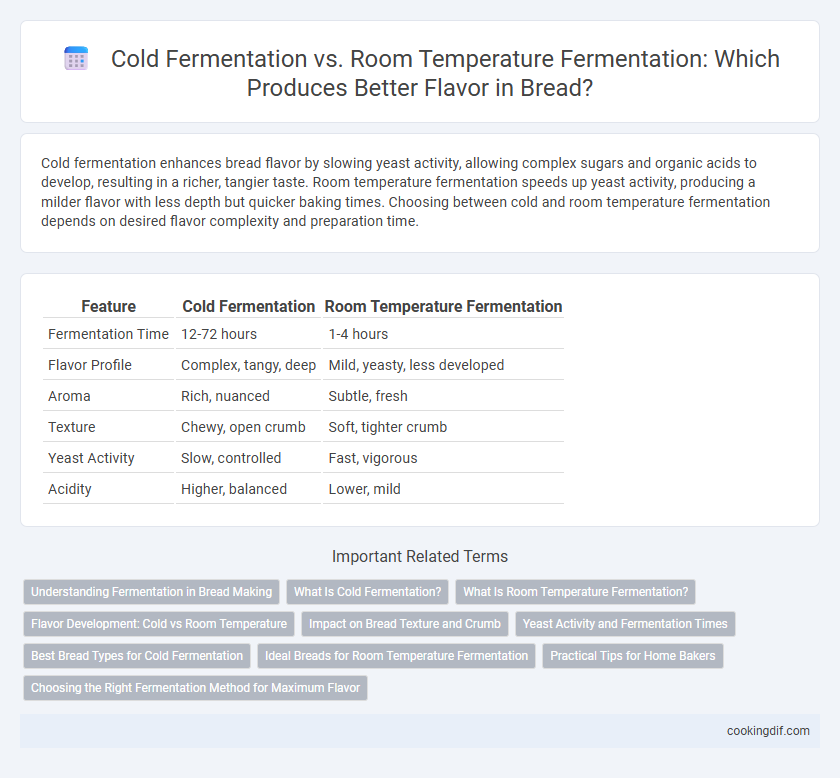Cold fermentation enhances bread flavor by slowing yeast activity, allowing complex sugars and organic acids to develop, resulting in a richer, tangier taste. Room temperature fermentation speeds up yeast activity, producing a milder flavor with less depth but quicker baking times. Choosing between cold and room temperature fermentation depends on desired flavor complexity and preparation time.
Table of Comparison
| Feature | Cold Fermentation | Room Temperature Fermentation |
|---|---|---|
| Fermentation Time | 12-72 hours | 1-4 hours |
| Flavor Profile | Complex, tangy, deep | Mild, yeasty, less developed |
| Aroma | Rich, nuanced | Subtle, fresh |
| Texture | Chewy, open crumb | Soft, tighter crumb |
| Yeast Activity | Slow, controlled | Fast, vigorous |
| Acidity | Higher, balanced | Lower, mild |
Understanding Fermentation in Bread Making
Cold fermentation slows yeast activity at temperatures around 4degC to 10degC, enhancing flavor complexity by allowing enzymes to break down starches and proteins over 12 to 72 hours. Room temperature fermentation, typically between 20degC and 25degC, accelerates yeast growth and carbon dioxide production, resulting in a quicker rise but simpler flavor profile. Understanding the impact of temperature on enzymatic reactions and yeast metabolism is crucial for bakers aiming to control texture, crumb structure, and taste in bread making.
What Is Cold Fermentation?
Cold fermentation is a bread-making process where dough is fermented at low temperatures, typically between 38degF and 50degF, for an extended period ranging from 12 to 72 hours. This slow fermentation allows yeast and bacteria to break down carbohydrates more thoroughly, enhancing flavor complexity and developing subtle sour notes. Compared to room temperature fermentation, cold fermentation produces bread with a richer taste profile and improved texture.
What Is Room Temperature Fermentation?
Room temperature fermentation involves allowing dough to rise at ambient indoor temperatures, typically between 68degF to 75degF (20degC to 24degC), which accelerates yeast activity for a faster rise. This method produces bread with a balanced, mildly tangy flavor and a softer crumb compared to cold fermentation. While less time-intensive, room temperature fermentation offers less depth in flavor development than the extended enzymatic activity in cold-fermented dough.
Flavor Development: Cold vs Room Temperature
Cold fermentation enhances bread flavor by allowing slow enzymatic activity, resulting in complex, tangy, and well-developed taste profiles. Room temperature fermentation accelerates yeast activity, producing sweeter, less nuanced flavors with a shorter development time. Bakers often prefer cold fermentation for artisanal bread due to its superior depth and richness in flavor.
Impact on Bread Texture and Crumb
Cold fermentation slows yeast activity, resulting in a denser crumb with enhanced flavor complexity due to prolonged enzymatic reactions. Room temperature fermentation produces a lighter, airier texture by accelerating yeast growth, which creates larger gas bubbles in the dough. The extended cold fermentation strengthens gluten structure, contributing to a chewier crust and more uniform crumb.
Yeast Activity and Fermentation Times
Cold fermentation slows yeast activity, extending fermentation times and enhancing complex flavor development through the gradual breakdown of carbohydrates. Room temperature fermentation accelerates yeast activity, producing quicker rise times but often results in simpler, less developed flavor profiles. Balancing fermentation temperature optimizes yeast metabolism, directly influencing the bread's aroma, texture, and taste complexity.
Best Bread Types for Cold Fermentation
Cold fermentation enhances complex, tangy flavors and is ideal for sourdough, baguettes, and ciabatta due to the slow yeast activity that develops deeper taste profiles. This method allows for longer proofing times at 38degF to 45degF (3degC to 7degC), resulting in improved gluten structure and crumb texture. Bread recipes benefiting most from cold fermentation include artisan loaves where flavor depth and crust crispness are prized.
Ideal Breads for Room Temperature Fermentation
Room temperature fermentation is ideal for breads that require a faster rise, such as sandwich loaves, focaccia, and certain rye breads, as it accelerates yeast activity for a shorter proofing time. This method enhances the bread's texture with a soft crumb and mild tang, making it perfect for everyday bread where a balanced flavor is desired without the complexity of long fermentation. Breads like baguettes also benefit from room temperature fermentation when a moderately open crumb and subtle flavor profile are preferred over the deep sour notes developed in cold fermentation.
Practical Tips for Home Bakers
Cold fermentation enhances bread flavor by allowing yeast to work slowly over 12-72 hours, developing complex aromas and improved texture. Room temperature fermentation speeds up the process, typically taking 1-3 hours, resulting in a milder taste but quicker bake times. Home bakers can optimize results by adjusting yeast amounts and monitoring dough temperature closely to balance flavor development and convenience.
Choosing the Right Fermentation Method for Maximum Flavor
Cold fermentation enhances bread flavor by allowing yeast to slowly break down sugars over 12 to 72 hours, producing complex, tangy notes and a chewier texture. Room temperature fermentation speeds up yeast activity within 2 to 4 hours, creating a milder taste and softer crumb. Selecting the right fermentation method depends on desired flavor intensity, with cold fermentation favored for richer, deeper flavors and room temperature suited for quicker, subtle results.
Cold Fermentation vs Room Temperature Fermentation for flavor Infographic

 cookingdif.com
cookingdif.com